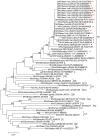Wild-type measles viruses with non-standard genome lengths
- PMID: 24748123
- PMCID: PMC3991672
- DOI: 10.1371/journal.pone.0095470
Wild-type measles viruses with non-standard genome lengths
Abstract
The length of the single stranded, negative sense RNA genome of measles virus (MeV) is highly conserved at 15,894 nucleotides (nt). MeVs can be grouped into 24 genotypes based on the highly variable 450 nucleotides coding for the carboxyl-terminus of the nucleocapsid protein (N-450). Here, we report the genomic sequences of 2 wild-type viral isolates of genotype D4 with genome lengths of 15,900 nt. Both genomes had a 7 nt insertion in the 3' untranslated region (UTR) of the matrix (M) gene and a 1 nt deletion in the 5' UTR of the fusion (F) gene. The net gain of 6 nt complies with the rule-of-six required for replication competency of the genomes of morbilliviruses. The insertions and deletion (indels) were confirmed in a patient sample that was the source of one of the viral isolates. The positions of the indels were identical in both viral isolates, even though epidemiological data and the 3 nt differences in N-450 between the two genomes suggested that the viruses represented separate chains of transmission. Identical indels were found in the M-F intergenic regions of 14 additional genotype D4 viral isolates that were imported into the US during 2007-2010. Viral isolates with and without indels produced plaques of similar size and replicated efficiently in A549/hSLAM and Vero/hSLAM cells. This is the first report of wild-type MeVs with genome lengths other than 15,894 nt and demonstrates that the length of the M-F UTR of wild-type MeVs is flexible.
Conflict of interest statement
Figures




Similar articles
-
Common position of indels that cause deviations from canonical genome organization in different measles virus strains.Virol J. 2016 Jul 29;13:134. doi: 10.1186/s12985-016-0587-2. Virol J. 2016. PMID: 27473517 Free PMC article.
-
Comparative investigation of the long non-coding M-F genome region of wild-type and vaccine measles viruses.Arch Virol. 1997;142(12):2521-8. doi: 10.1007/s007050050259. Arch Virol. 1997. PMID: 9672611
-
Measles virus genotype D4 strains with non-standard length M-F non-coding region circulated during the major outbreaks of 2011-2012 in Spain.PLoS One. 2018 Jul 16;13(7):e0199975. doi: 10.1371/journal.pone.0199975. eCollection 2018. PLoS One. 2018. PMID: 30011283 Free PMC article.
-
Constraints on the Genetic and Antigenic Variability of Measles Virus.Viruses. 2016 Apr 21;8(4):109. doi: 10.3390/v8040109. Viruses. 2016. PMID: 27110809 Free PMC article. Review.
-
Virology of measles virus.J Infect Dis. 1994 Nov;170 Suppl 1:S15-23. doi: 10.1093/infdis/170.supplement_1.s15. J Infect Dis. 1994. PMID: 7930749 Review.
Cited by
-
Case Study: Contribution of Extended Sequencing and Phylogeographic Analysis in the Investigation of Measles Outbreaks in Tunisia in 2019.Vaccines (Basel). 2024 Sep 23;12(9):1085. doi: 10.3390/vaccines12091085. Vaccines (Basel). 2024. PMID: 39340115 Free PMC article.
-
Analysis of a Subacute Sclerosing Panencephalitis Genotype B3 Virus from the 2009-2010 South African Measles Epidemic Shows That Hyperfusogenic F Proteins Contribute to Measles Virus Infection in the Brain.J Virol. 2019 Feb 5;93(4):e01700-18. doi: 10.1128/JVI.01700-18. Print 2019 Feb 15. J Virol. 2019. PMID: 30487282 Free PMC article.
-
Near-Complete Genome Sequence of a Swine Norovirus GII.11 Strain Detected in Japan in 2018.Microbiol Resour Announc. 2020 Apr 23;9(17):e00014-20. doi: 10.1128/MRA.00014-20. Microbiol Resour Announc. 2020. PMID: 32327514 Free PMC article.
-
Complete Genome Sequences of Six Measles Virus Strains.Genome Announc. 2018 Mar 29;6(13):e00184-18. doi: 10.1128/genomeA.00184-18. Genome Announc. 2018. PMID: 29599155 Free PMC article.
-
Singapore's efforts to achieve measles elimination in 2018.Western Pac Surveill Response J. 2021 Jul 12;12(3):5-16. doi: 10.5365/wpsar.2019.10.4.002. eCollection 2021 Jul-Sep. Western Pac Surveill Response J. 2021. PMID: 34703631 Free PMC article.
References
-
- Rima BK, Duprex WP (2009) The measles virus replication cycle. Curr Top Microbiol Immunol 329: 77–102. - PubMed
-
- Richardson C, Hull D, Greer P, Hasel K, Berkovich A, et al. (1986) The nucleotide sequence of the mRNA encoding the fusion protein of measles virus (Edmonston strain): a comparison of fusion proteins from several different paramyxoviruses. Virology 155: 508–523. - PubMed
-
- Heider A, Santibanez S, Tischer A, Gerike E, Tikhonova N, et al. (1997) Comparative investigation of the long non-coding M-F genome region of wild-type and vaccine measles viruses. Arch Virol 142: 2521–2528. - PubMed
Publication types
MeSH terms
Substances
Associated data
- Actions
- Actions
- Actions
- Actions
- Actions
- Actions
- Actions
- Actions
- Actions
- Actions
- Actions
- Actions
- Actions
- Actions
- Actions
- Actions
- Actions
- Actions
- Actions
Grants and funding
LinkOut - more resources
Full Text Sources
Other Literature Sources
Research Materials

